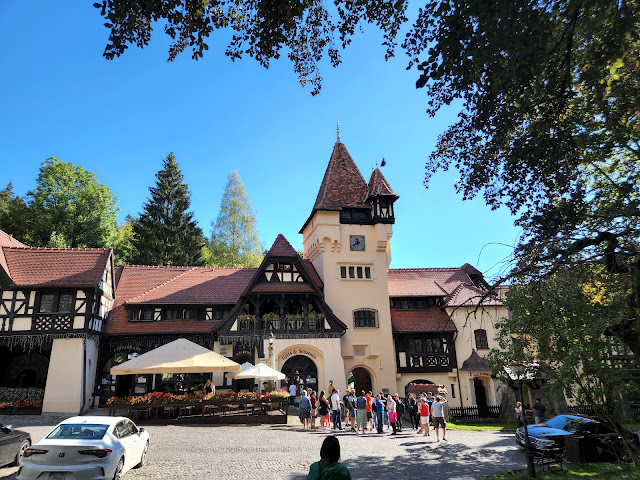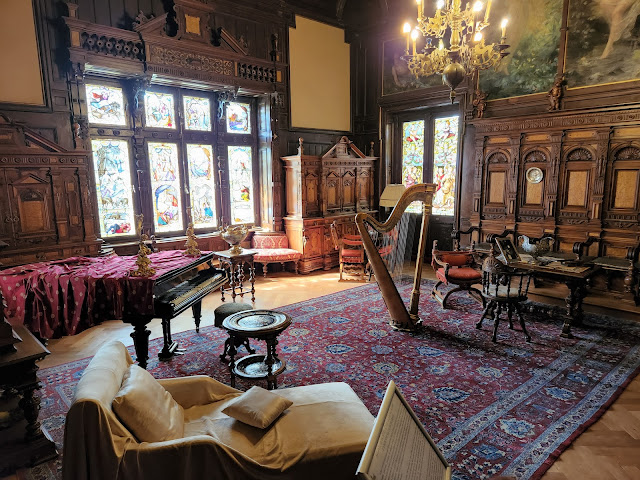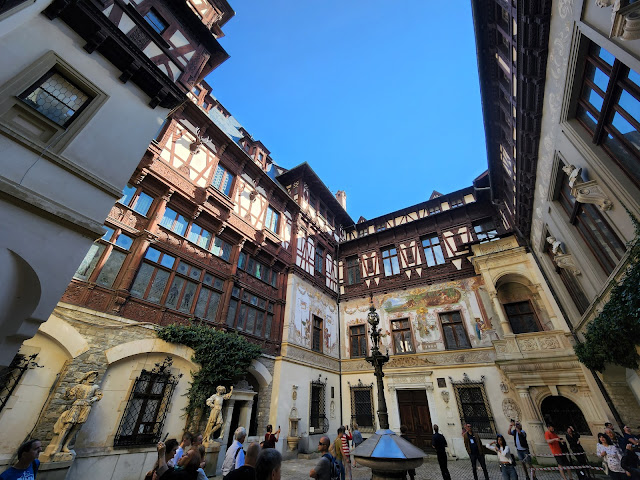We were a little sad to be leaving Brasov, as there was much more to see and we simply didn't have enough time. For reasons that are still not entirely clear, we had a new bus driver this morning. We've always had the same driver for all of our tours, but the day before we'd been told that our regular driver had to depart, and a new one was being sent up from Bucharest. Kevin, the former Gate1 employee, believed it had to do with an arcane EU law regarding driving times and assignments for bus drivers. I won't pretend to recreate the rule as he explained it to me, as it made next to no sense, but given some of the labor laws in France, for example, nothing would surprise me.
Weather was again spectacular and the opposite of what had been forecast. Our destination this morning was the Peles royal castle in Sinaia. As a picture of the castle graces the cover of our travel guide, I had been anticipating this stop. Over the course of the tour, we'd already heard quite a bit about the Romanian royal family, but today would involve an even deeper dive, including the drama carrying through to this very day. In 1859, the principalities of Moldova and Wallacia (southern and northeastern Romania) were united one one country, with a titular prince at its head. That did not not last long and was not very stable, so the ruling elite decided they needed to install a "stable" royal family. And where do you go for stability? Why, Germany of course. Carol, the son of a prince within the Hohenzollern-Sigmaringen family, accepted the proposal to become King of Romania. This is the same family that produced "crazy" King Ludwig of Bavaria. He became a prince in 1866, and while foreign born and not very popular, he raised in stature, particularly after leading Romanian troops in their successful campaign against the Ottoman Turks in 1877. It was that defeat and Romania's ultimate independence from the Ottoman Empire that led to his proclamation as king in 1881, and Romania officially became a monarchy. Carol and his wife only had one child, a daughter, who died in infancy, so there was no heir apparent when the king passed away in 1914. Carol's brother had three sons, but both the brother and eldest son renounced the crown, so it fell to second-born Ferdinand, who was married to Marie, a granddaughter of Queen Victoria.
Before he died, as WWI was looming, King Carol voiced his support for Germany, should war breakout. Hostilities began after Ferdinand ascended to the throne, and he attempted to remain neutral for a time. That became impossible, and at the strong urging of Marie, Romania ended up declaring war on Germany in 1916 (Ferdinand's home country). As they ended up on the winning side, the Treaty of Versailles laid the groundwork to restore Transylvania to Romania. Ferdinand and Marie were then official coronated as King and Queen of Greater Romania in 1922 -- in the church I wrote about when we visited Alba Iulia.
I'll take a pause here and write about Peles Castle, which we were about to visit. From Brasov, we again (and for the final time) started to climb up and through the Carpathians. The terrain here was markedly alpine in nature, and it looked like we were in Bavaria or Austria. We passed through multiple toney looking ski resorts, many with casinos and lavish-looking hotels and spas.
After Carol I became king, he visited this area and -- as it reminded him of home -- he elected to build a summer residence and hunting lodge here. This grew into Peles Castle. Work on the castle ran for over thirty years, but the king and queen occupied large parts of it before completion, and spent summers here. The exterior does have a very German look to it, ala Neuschwanstein. There were quite a few other visitors in the little town, but it was nowhere near the mayhem of Bran Castle. Our regular guide actually led our tour through the castle, and her level of knowledge was really impressive. The interior of the place far exceeded our expectations. Every room was a work of art, and it managed to not be gaudy or TOO over the top. Reportedly Emperor Franz Josef and Sofie visited Peles, and declared it the most magnificent castle in all of Europe. I think both of us would have liked more time to explore the rooms, but there was simply so much to see. We were fascinated to learn that the interior paintings were done by Gustav Klimt and his brother Franz. Those paintings include numerous originals, but the Klimt's also created several reproductions of various masterpieces. If given the opportunity, I would love return and spend an entire day just exploring all the various rooms and treasures. Our guide lamented near the end that we had to proceed through, as other groups were coming in behind us. She said that before Covid, they only let groups go through, and it was all timed. If you were not part of a tour, you waited until a group reached sufficient size, and then you were let in. Since Covid, and as they really need money for the upkeep, they started to allow individuals in, and that has resulted in more foot traffic.
When the communists came to power, the palace and all its treasures became property of the state. It was set aside for use by "Romanian cultural personalities." Under Ceausescu, though, it was closed entirely from 1975, and remained so until 1990. I asked how they managed to protect all of the original treasures, which could have easily been destroyed or sold off for hard currency. Evidently Ceausescu didn't like the place, and knowing of his extreme paranoia, he was told that there was a rare form of wood rot in the rafters, which could make him sick. That ploy seemed to work, and thank goodness everything survived. The castle, by the way, was returned to the royal family in 1997, and the current heir still uses it on special occasions, but she decreed that it remain open to the public as a museum.
 |
| Exterior Housing (former for servants) at Peles Castle |
 |
| Peles Castle |
 |
| Primary Reception Hall |
 |
| Full set of Armor Within the Armory |
 |
| Evidently King Carol I Was a Collector |
 |
| Painting of Queen Elizabeth (Carol I's wife) by Klimt (unique, as it showed the Queen as maternal) |
 |
| King's Study |
 |
| The Music Room |
 |
| More Paintings by Gustav Klimt |
 |
| The Moorish Reception Hall |
Before heading back to the bus, we enjoyed a long sit in the sun, along with some cake and coffee. Ironically, while here, we "collided" with two other Gate1 tours. I may have mentioned earlier that while Gate1 has three tours that include Romania, we were on the only one that remained solely in the single country. Our visit coincided with another tour -- Serbia, Romania, and Bulgaria -- that was just beginning their journey, as well as one of their so-called Discovery Tours, called Majestic Balkans. That tour went as far as Albania, and Discovery Tours are designated as "small groups." We laughed, though, when we learned that they had 17 in their group, whereas our "Classic" tour only had 16.
As we drove out of Sinaia, we passed the train station where the Orient Express still stops to this day. A short while, later, too, the skies opened up and it poured rain for over an hour. Our next stop was Bucharest and, as we had seen Peles in brilliant sunshine, none of us were too disappointed.
During the drive south, we heard more about the royal family and sad legacy post King Ferdinand and Queen Marie. The king's crown prince was his eldest son, Carol II. The heir, however, was a notorious scoundrel and womanizer. Reportedly he'd be diagnosed as a sex addict in today's parlance. He initially secretly married a dancing girl, but that marriage ended up being annulled, once the family became aware. He was then forced to marry a princess from Greece, who gave birth to a son -- Michael -- seven months after their marriage. Carol II had no interest in his new wife or child, and he renewed a relationship with a woman with whom he had an affair in his 20's. He ended up renouncing the throne in 1925 entirely, abandoning his family, and moving Paris to live with his mistress. Parliament was forced to declare his son, Michael, as the new crown prince. King Ferdinand died in 1927, and young Michael became king at the age of six.
A regency was established to rule on behalf of Michael, but that did not last, and powerful politicians enticed Carol II to return from exile and become king in 1930. He quickly turned into an autocrat and eventually ended up dissolving all the political parties and having the constitution amended to give him even more power. As part of the Nazi-USSR non-aggression pact, however, Romania lost territory to the Soviet Union (the part of Moldova I mentioned earlier, and some other ancillary territory on the Black Sea). This forced Parliament's hand, and they forced Carol II to abdicate in 1940. That put Michael back in line for the throne, but he was only 19, and the senior general in the country -- Ion Antonescu -- convinced him that he had not yet reached majority in terms of "age and mind." The new king essentially deferred all power to Antonescu, who declared war on the Soviet Union a year later, in hopes of retrieving the territories lost earlier. That move aligned Romania with the Axis powers, and was a fateful decision. The country quickly became the number one source of oil for the Nazi regime.
King Michael lamented the alliance with Germany and, sensing imminent defeat, he staged a coup in late 1944, had Antonescu arrested, and announced Romania's switch to the Allied side. That decision ended up being key to Romania's survival as a country. Though Romania ended up on the winning side, communists had been building in power and Stalin forced Michael to accept a prime minister of his choosing, and Michael became a figurehead. He traveled to England in 1947, when and where he met his wife, and he was offered asylum by King George VI. Michael declined, returned to Bucharest, and was quickly ambushed and forced to abdicate at gunpoint, appointing Gheorghe Dej, who was the first of Romania's two communist leaders. Ceausescu was the second and last. Historians credit Michael's decision to push Romania toward the Allies with saving the country, even if it was not his intent. As soon as they switched sides, Germany lost their primary source of oil, which hastened the end of the war. If the war had ended with Romania on the losing side with Germany, the modern consensus is that Romania would have been absorbed into the Soviet Union, rather than permitted to remain as a separate country, albeit in the Soviet orbit and serving as a buffer state.
Sorry to ramble on, but to close out the drama of the royal family. Michael tried to return to Romania to visit his parents' graves in 1990, after the government fell, but was stopped. It was not until 1997 that his Romanian citizenship was restored and he was allowed to return to visit. He ended up dying in Switzerland at the age of 96 in 2017. Michael never had a son, and the original agreement with the Hohenzollern-Sigmaringen family had been that only men could inherit the throne. If there was no male heir, the title would revert to the family in Germany. In this case, it would have gone to a grandson, also named Michael, in whom Michael had little faith for still unclear reasons. Before he died, he issued a decree declaring his daughter Margareta as his heir. The entire squabble is technically moot and useless, as the royal family is prohibited from resuming control or claiming any authority under the new Romanian Constitution. That said, the internal family squabble is still fodder for tabloids. Michael (the snubbed grandson) is very popular, speaks Romanian very well, and spends time in the country, whereas Margareta is said to speak little to no Romanian and seems disinterested in even trying. Evidently, too, the younger Michael even changed his name officially to be "Prince Michael of Romania," so the whole thing is rather silly.







No comments:
Post a Comment